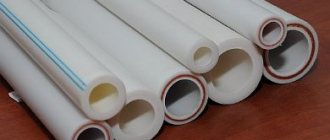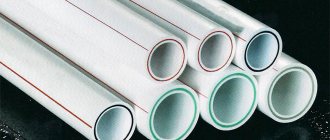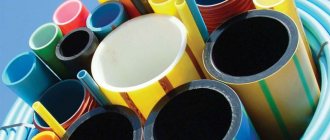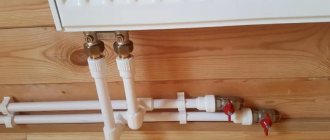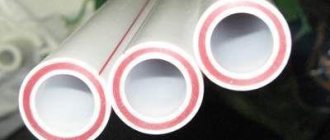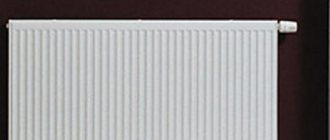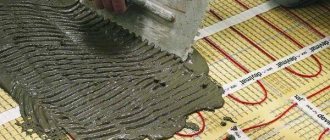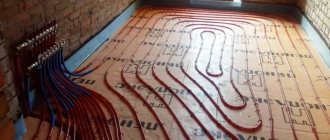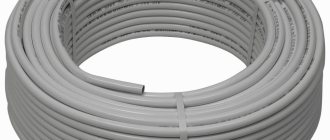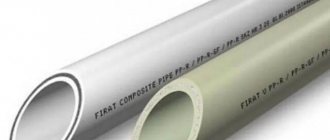Today, increasingly, plumbing and heating systems are made not from steel pipes, but from polypropylene. But this is plastic, and the question arises - what is the maximum temperature that a polypropylene pipe can withstand?
Let's look at this issue in more detail. Let's consider the properties of polypropylene material. Let's get acquainted with the types of polypropylene pipes and their characteristics. We’ll also talk about the temperatures that this pipeline can withstand, and the features of its use in hot water supply lines.
Properties of polypropylene
Polypropylene is a synthetic polymer product in the form of a white powder; a profile is made from it by melting or pressing. This is the hardest and most resistant type of plastic, not subject to corrosion.
The main physical properties of polypropylene are durability, reliability, wear resistance, and resistance to high temperatures. It is not susceptible to the action of chemicals, salts and alkaline solutions, so these substances in water are not dangerous for this pipeline.
Polypropylene products:
- weigh less than steel;
- do not emit substances harmful to health - suitable for installation in domestic premises;
- the inner surface is smooth, which does not allow scale deposits;
- the level of thermal conductivity is low;
- good sound insulation;
- high electrical insulation;
- heat capacity index 2.0 kJ/(kg.°C);
- permissible temperature level -15 - +120;
- density value – 0.92 kg/cm³.
Polypropylene softens at +140 degrees, and the melting point is +175 - this is the temperature of steam.
This factor makes a polypropylene pipeline suitable for cold or hot water supply (especially reinforced ones) , where the temperature of the coolant is kept at +95, but it cannot be used as a steam pipe.
When heated, polypropylene becomes soft, and after cooling, all its physical properties return to it, and it becomes hard again, so assembling a water main from these products is appropriate, and the process of connecting pipeline elements is quite simple. It is enough to heat its ends and join them; it is also possible to connect them with couplings.
The main disadvantage of polypropylene is its plasticity. When heated, the product softens and can be easily bent. But when such a profile is bent, the internal diameter decreases significantly and the throughput level decreases.
In addition, this material is afraid of light; the product may lose its shine, crack, or fade. To avoid this, various components are added to polypropylene.
It is worth noting that polypropylene does not tolerate frost well; it becomes brittle at temperatures ranging from minus 5 to 15 degrees. This material deficiency can also be eliminated by adding ethylene or ethylpropylene rubber.
The standard pressure indicator for polypropylene products is 30 kg per 1 cm2. But according to manufacturers’ recommendations, it should not exceed 10 kg.
Color
PP pipes come in different shades. The color indicates the operational features of the part:
- White - used for the manufacture of pipelines inside apartments and private houses. Easy to connect, which speeds up installation. Not suitable for making outdoor water pipes. The material quickly loses strength when the temperature drops below 0 degrees.
- Gray - suitable for the manufacture of heating systems. This is due to its high thermal stability.
- Black - sewer drains and drainage channels are made from such tubes. By adding chemicals to the composition, manufacturers improve the technical characteristics of products.
- Green - used for the manufacture of liquid supply systems for garden plots and vegetable gardens. Cannot withstand high water pressure.
Green colored pipelines should be checked more often than others. Due to low strength, leaks and breakdowns often occur in the system.
Black polypropylene pipes
Types of polypropylene pipes
Polypropylene pipes are divided into two main types: reinforced or unreinforced . They are also divided according to their layout and material of manufacture. If the product has a blue stripe, then it is recommended for cold water supply, and a red one for hot water supply.
Products made of polypropylene of any type are marked with the letters PN. The number next to the abbreviation PN affects the cost, and accordingly, the larger it is, the higher the price.
Polypropylene and Heating? It makes sense?
unreinforced
The purpose of non-reinforced types is cold water lines. They are not suitable for hot water supply, since when heated, the pipeline can lengthen - every 10 meters by 150 mm, which will cause it to rupture. Although, in low-temperature structures, installation of unreinforced models is possible, but only if the pressure is not high.
Such types have increased flexibility, ductility and low cost. Conventional profiles are easy to install, since the connection areas with the fitting are free of obstacles.
The following markings are placed on polypropylene products, which indicate the permissible maximum temperature:
- PN 10 - permissible temperature + 45 (for floor heating) and + 20 (for water supply), pressure 1 MPa. Wall thickness - 10 mm, diameter - from 20 to 110 mm.
- PN 16 - permitted pressure 1.6 MPa, temperature value + 60. Wall thickness from 3.4 mm.
- PN 20 - permissible pressure of 2 MPa, at a temperature of + 80 degrees. Wall thickness 16 - 18.4 mm.
The service life of unreinforced mains when used in cold water supply reaches 50 years, 30 years if heated coolant moves through them.
Reinforced
Reinforcement - the presence of an additional aluminum or fiberglass layer. This material makes the product stronger, increases its service life, even in the presence of hot coolant, the profile will last up to 50 years.
In addition, reinforcement allows the use of this pipeline with water heated to + 120 degrees, without the risk that linear expansion will occur, with further rupture of the line.
The purpose of models with reinforcement is hot water supply with high pressure. This type:
- more resistant to chemicals;
- its expansion coefficient is 5 times lower than the usual profile;
- ability to withstand high temperatures and maximum loads.
According to the reinforcement material, profiles are:
- With an aluminum layer - these models have a high operating pressure level, so they are suitable for central heating and hot water. The aluminum layer reduces the degree of thermal deformation and oxygen diffusion.
Installation of an aluminum-reinforced profile is difficult, since contact of the aluminum layer with water is not allowed. Therefore, the joints must be cleared of a few centimeters of the reinforcing coating.
- Fiberglass reinforced - have a low level of expansion. Fiberglass fiber reduces deformation when heated. Compared to aluminum models, such products have a lower heating pressure, so they are less in demand.
The installation process of this type is simpler, because no stripping is required. Fiber fibers are connected to each other with molten polyethylene, and there is no delamination of the material.
- Pipes reinforced with basalt fiber. This type has a lot of advantages, compared not only with any reinforced models, but also with profiles made of plastic and metal. It is easier to install compared to aluminum coating, since there is no need to strip it. Basalt products are easily connected to any types of polypropylene fittings.
Reinforced pipes are marked PN 20 and PN 25. They are able to withstand temperatures of + 95 and pressures of up to 2.5 MPa.
But not all reinforced products are able to withstand higher degrees of heating. For example, aluminum ones cannot withstand the temperature that a fiberglass-reinforced polypropylene pipe can withstand - + 120 (although also not for a long time).
Specifications
Resistance to various factors affects the properties of PP products.
Fragment of the heating system
The main characteristics of the products include:
- Maximum permissible pressure depending on the temperature of the transported medium. As it increases, the maximum value of this parameter decreases. PP pipes generally withstand from 4 to 6 atm if the coolant temperature is 70 °C.
- Thermal stability, allowing to withstand short-term increases in the temperature of the transported medium up to a maximum of 95 °C. This happens extremely rarely in the heating circuits of residential buildings. The material begins to soften at 110-140 °C, and melt at 140-170 °C.
- Low heat conductivity, preventing the appearance of condensation on the pipeline. Thanks to this characteristic, its surface and the moving coolant will have almost the same temperature.
- Resistant to corrosion. It manifests itself as a lack of response to exposure to water. PP pipes have a smooth inner surface. Therefore, salts do not accumulate in them. This allows them to compete adequately with other types of pipes.
- Service life is about 50 years. It exceeds the durability of steel products by almost 2 times. This property of PP products depends on the heating scheme, operating pressure and temperature changes of the transported medium.
Marking
In addition to the PN marking, which indicates temperature and pressure, all plastic pipes have:
- the word "pipe";
- abbreviated name of the material;
- SDR - the value of the ratio of the external size to the thickness of the walls;
- external profile size;
- operational class;
- working pressure limit;
- Standart room.
For example:
Pipe PP-R SDR 11-20´ 1.9 class 1/1.0 MPa GOST R 52134-2003, where:
- random polypropylene profile - SDR 11 copolymer;
- outer diameter 20 mm;
- wall thickness 1.9;
- class 1;
- permissible pressure 1 MPa.
According to their structure, profiles are divided into:
- S - single-layer;
- M - multilayer;
- TI - with a thermal insulation layer;
- PP - standard;
- PP-RP - high pressure resistant.
By type of material there are:
- PPB - they have high strength, their purpose is floor heating with hot coolant;
- PPH - have an increased internal diameter, mounted on ventilation systems and cold water;
- PPR is a universal type that can withstand elevated temperatures.
By class they are divided into:
- class 1 - up to +60 C, intended for water supply;
- 2 - up to +70 (pipelines);
- 3 - + 60 (warm floors);
- 4 - +70 C, used for heating;
- 5 - + 90 (heating);
- class XB - for cold water supply.
Some manufacturers put a trademark on their products.
Temperature table
For clarity, we have presented a table of temperatures that polypropylene pipes can withstand.
| View | Purpose | Maximum temperature level | Working pressure (atm) |
| PN 10 | Cold water supply | +40 C | 10,2 |
| PN 16 | Universal model | +60 | 16,3 |
| PN 20 | Universal | +80 — 95 | 20,4 |
| PN 25 | Hot water | +95 — 120 | 25,5 |
Features of use in a heating system
Destruction temperature of polypropylene pipes.
Today, polypropylene profiles are increasingly installed both in central heating systems and are used to heat private buildings. They do not deform, do not allow oxygen to pass through, are able to withstand sub-zero temperatures and, as a result, freezing of water in the main does not cause damage to the system as a whole.
To the question of which polypropylene pipe for heating is best to purchase, you can give a clear answer - you need to take a pipe that can withstand a maximum temperature of +60 - +95 C. The most suitable models are PN 20 with a heating degree of +60 or PN 25 - +95.
When choosing polypropylene profiles for heating, in addition to temperature, you should consider that:
- Plastic products are rigid and difficult to bend. To turn the highway, you need to install an angle, which is not very convenient.
- The cross-section of the pipes must correspond to the size of the risers to which they will be connected. In a private house, the central wiring is made from a profile with a cross-section of 32 mm, the connection to the batteries is made with pipes measuring 20 - 25 mm.
- PP pipe fittings have a large cross-section, which worsens the appearance of the system.
- Polypropylene stretches when heated, this leads to thinning of the walls and sagging of the pipeline, which looks unsightly when installed openly.
When installing a plastic pipeline, it is important not to overheat it, as this will lead to a decrease in the passage when inserting it into the fitting. This error significantly reduces the efficiency of the system.
In addition, polypropylene products are not recommended for piping boilers. In the boiler room there is a frequent change in temperature, which is contraindicated for this profile.
If you take into account all the above points, then polypropylene types with a maximum temperature of +95 are quite suitable for heating.
Features of installation in a private house
When installing a heating network in a private house, a 2-pipe system is usually installed. Work begins after selecting the boiler. In cottages and other similar buildings, solid fuel is used. In addition, gas and electric heating equipment. Its type depends on the type available.
PP heating system in a private house
In private homes, the heating system can be performed with natural and forced circulation of coolant. In the first case, an expansion tank and air outlets are used, and in the second option, a pump is built into the network.
Radiators are connected to the heating circuit using a bottom, side or diagonal connection. The first option is often used in cottages and mansions. The second connection method is most often performed in multi-storey buildings.
The diagonal connection is effective when the pipelines are long and at least 10 radiators are installed. This option allows you to reduce heat loss by up to 2%.
Application of polypropylene pipes in hot water supply
When installing a hot water line, you must remember that polypropylene pipes have a high expansion coefficient when heated. If the heating level of the coolant increases by 10 degrees, then the polypropylene pipeline increases by 1.25 mm per meter. When using reinforced - 0.32 mm/m.
The heating temperature of the coolant supplied to individual consumers ranges from + 45 to 75 degrees. Based on this, in order to ensure uninterrupted supply of such systems, it is recommended to install reinforced polypropylene pipes of grade PN 20 or 25, with a pressure of 2 to 2.5 MPa.
Polypropylene, a common material in the production of water pipes. With the right model, and if you follow all the recommendations for using polyethylene pipes, they will serve you for decades.
Testing polypropylene ch1
Criterias of choice
When choosing polypropylene tubes, you need to pay attention to several factors:
- required temperature conditions;
- maximum pressure of liquid or gas;
- service life;
- diameter
Manufacturers:
- Banninger is a German company that makes its products from random copolymers. It is suitable for assembling water supply systems and drinking water supply.
- Valtec is an Italian company that produces thin-walled aluminum and fiberglass reinforced parts.
- Kalde is a Turkish company that produces products from pure polypropylene, which can be reinforced with aluminum foil and fiberglass.
- Wavin Ekoplastik is a Czech manufacturer that produces tubes that can withstand pressures of up to 20 atmospheres. Additionally they can be reinforced with aluminum foil.
- SPK is a Turkish company that produces inexpensive parts of good quality.
- Tebo is a Turkish manufacturer that produces products made of pure plastic or with a reinforcing coating.
Polypropylene pipes quickly replaced metal products from everyday use. They incorporate the best of different materials, but are sold at a low price. Easy installation allows you to save additional money if you do the work yourself.
Leading manufacturers
Rehau has been considered the constant leader among manufacturers of polypropylene pipes and fittings for many years. The company's developers have come up with a reliable method for connecting pipes using corners and other connecting elements.
However, since rehau fittings appeared, a lot of water has passed under the bridge. The market is literally flooded with companies offering their own new polypropylene products. Every manufacturer wants to stand out with their products, but who should you really trust? Here we will designate only those brands that consumers themselves have noted as the best.
The entire heating system can be made from polypropylene, even in large houses
German companies are coming first. They perfectly manage to produce high-quality products, introducing the unique durable properties of polypropylene into their plastic products: Akwatherm, Banninger, Rehau.
Reliable manufacturers of polypropylene pipes and connecting parts - Czech Republic WavinEcoplastic, Valtec - Italian parts.
Fittings from Rehau Germany, products from the Turkish company KALDE, and Russian RVC are popular. Reviews of products from China, Turkey, and Ukraine vary: laudatory ones alternate with negative ones. This confrontation is associated with numerous underground counterfeits. Wear-resistant ppr products produced by industrial plants receive no complaints.
